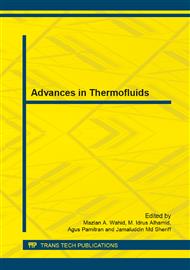p.206
p.213
p.217
p.223
p.229
p.235
p.241
p.246
p.251
Design of a Four-Stroke Homogeneous Charge Compression Ignition Engine
Abstract:
This research is to study the operation of the four-stroke HCCI engine. The design and analysis works have been performed using computer software which is GT-Power and Solidwork to study on the engine performance simulation work and 3-D modelling on the combustion chamber designed respectively. The design is based on 4-cylinder passenger car, 2000 cc and a four-stroke cycle engine. The compression ratio used is 10. The fuel used is ethanol in which the air-fuel ratio (AFR) is 9. The parameters selected have typical range of value based on the previous study and research done. With the use of GT-power, the analysis will consider two parameters which are the cam timing angle and the injection timing angle to get the optimum result for the HCCI engine. The typical angle of cam timing angle is between 2600 – 2700 since this is the moment of the compression cycle of the engine. For the injection timing angles, the angles that will be studied for this project are 50, 00, -50, -100,-150 and -200 relative to Top Dead Centre (TDC). The objective is to obtain the maximum torque and brake power when the engine speed is in between 4000 rpm to 5000 rpm and 6000 rpm to 7000 rpm respectively. Finally, the optimum conditions for the engine to perform better are at 2640 of cam timing angle for the valve and at -50 before TDC for the injection timing angle. The maximum torque and brake power achieved is 37.60 Nm at 4000 rpm and 23.46 kW at 7000 rpm.
Info:
Periodical:
Pages:
229-234
Citation:
Online since:
August 2013
Price:
Сopyright:
© 2013 Trans Tech Publications Ltd. All Rights Reserved
Share:
Citation:


